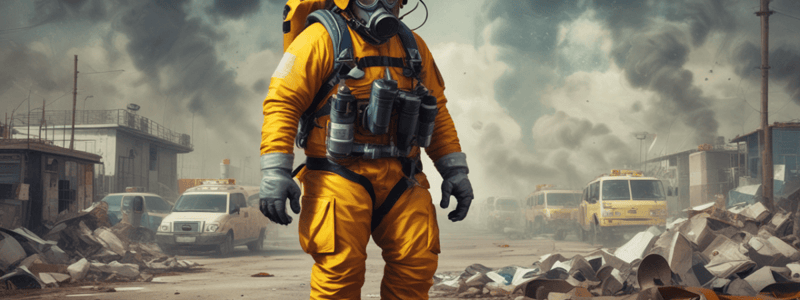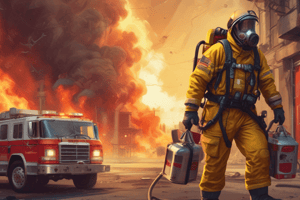Podcast
Questions and Answers
What is the minimum oxygen percentage required in the air for the heat exchanger to function?
What is the minimum oxygen percentage required in the air for the heat exchanger to function?
- 15%
- 25%
- 20%
- 19.5% (correct)
What is the maximum humidity level in which the heat exchanger can function?
What is the maximum humidity level in which the heat exchanger can function?
- 95% (correct)
- 105%
- 100%
- 90%
What is the purpose of the heat exchanger in the breathing tube?
What is the purpose of the heat exchanger in the breathing tube?
- To warm the inhaled air
- To humidify the inhaled air
- To filter the inhaled air
- To cool the inhaled air (correct)
What happens when the unit is exposed to higher levels of carbon monoxide?
What happens when the unit is exposed to higher levels of carbon monoxide?
What is the service life of the unit when properly stored?
What is the service life of the unit when properly stored?
What is the purpose of the quick start system?
What is the purpose of the quick start system?
What is the reaction between the potassium hydroxide and the carbon dioxide from the exhaled breath?
What is the reaction between the potassium hydroxide and the carbon dioxide from the exhaled breath?
What is the purpose of the breathing bag?
What is the purpose of the breathing bag?
What is the function of the regulator in the backpack assembly?
What is the function of the regulator in the backpack assembly?
What is the purpose of the facepiece (mask)?
What is the purpose of the facepiece (mask)?
Flashcards are hidden until you start studying
Study Notes
Emergency Response Guidebook
- Emergency Response Guidebook for Incidents Involving Hazardous Materials
- Material Safety Data Sheets (MSDS) or Information Sheets provided by the manufacturer for all products on-site
- CANUTEC (Canadian Transport Emergency Centre, a 24-hour national emergency response advisory service) and WISER (Wireless Information System for Emergency Responders)
Western Canada Mine Rescue Manual
Chapter 3: Environmental Conditions
- Avalanche terms, concepts, and equipment
- Ice travel and thermal stress
- Avalanche Zones:
- Starting Zone: Where the unstable snow first breaks away, characterized by incline, slope aspect, exposure to wind, elevation, and exposure to sun
- Track: Below the starting zone, where the avalanche accelerates and reaches maximum destructive potential
- Run-out Zone: Where the avalanche decelerates and finally comes to rest
Chapter 3: Symptoms of Avalanche
- Fast breathing
- Absence of sweating
- Shock
- Cardiac arrest
- In later stages, a person may pass out and have convulsions
Western Canada Mine Rescue Manual
Chapter 5: Gases and Hazardous Atmospheres
- Terms, concepts, and formulae
- The properties and effects of mine gases
- Physiological Effects of Sulphur Dioxide Exposure:
- Concentrations of SO₂ in the Atmosphere (PPM):
- 0 - 0.25: Mild to severe irritation to eyes, nose, and throat
- > 0.25: Life-threatening condition from accumulation of fluid in the lungs (pulmonary oedema)
- Concentrations of SO₂ in the Atmosphere (PPM):
Respiratory Protection
- Require at least 19.5% oxygen in the air
- Function in an environment with no more than 95% humidity
- Protect the wearer against 1% (10,000 PPM) carbon monoxide for one hour
- Generate heat when exposed to higher levels of carbon monoxide, thereby shortening the unit's duration
- Wearers must be in a respirable atmosphere before removing the unit
- Have a service life of 10 years and a shelf life of 15 years when properly stored
- Require testing as per manufacturer's specifications
Self-Contained Breathing Apparatus (SCBA)
- Oxygen is released by the chemical reaction of moisture from the exhaled breath mixing with the potassium superoxide (KO
2) - The oxygen is inhaled from the breathing bag, which also serves as a breathing air reservoir
- A heat exchanger is built into the breathing tube to cool the air before inhalation
- A quick start system covers the immediate oxygen requirements of the user until the chemical of the canister becomes activated
Types of SCBA
- Dräger - PSS BG4
- Bio Marine - BioPak 240R
Components of SCBA
- Backpack Assembly: Designed to hold the air cylinder on the rescuer's back
- Regulator: Reduces the cylinder pressure to flow and pressure levels required for inhalation
- Facepiece (Mask): Designed to deliver low-pressure air from the regulator into the mouth and nose of the rescuer
Studying That Suits You
Use AI to generate personalized quizzes and flashcards to suit your learning preferences.




